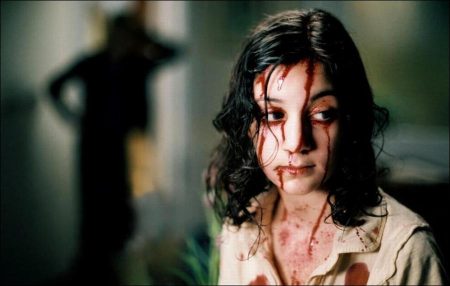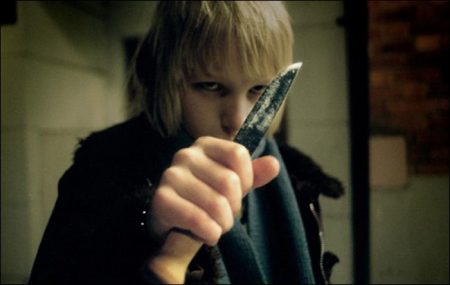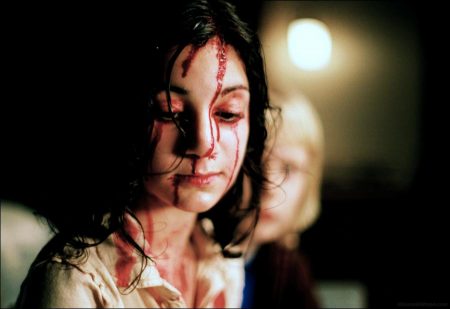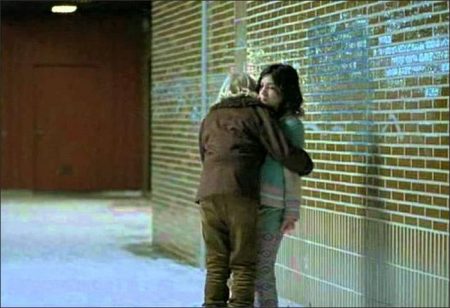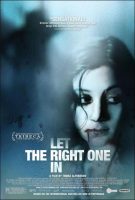Let the Right One In movie storyline. A fragile, anxious boy, 12-year-old Oskar is regularly bullied by his stronger classmates but never strikes back. The lonely boy’s wish for a friend seems to come true when he meets Eli, also 12, who moves in next door to him with her father. A pale, serious young girl, she only comes out at night and doesn’t seem affected by the freezing temperatures.
Coinciding with Eli’s arrival is a series of inexplicable disappearances and murders. One man is found tied to a tree, another frozen in the lake, a woman bitten in the neck. Blood seems to be the common denominator – and for an introverted boy like Oskar, who is fascinated by gruesome stories, it doesn’t take long before he figures out that Eli is a vampire.
But by now a subtle romance has blossomed between Oskar and Eli, and she gives him the strength to fight back against his aggressors. Oskar becomes increasingly aware of the tragic, inhuman dimension of Eli’s plight, but cannot bring himself to forsake her. Frozen forever in a twelve-year-old’s body, with all the burgeoning feelings and confused emotions of a young adolescent, Eli knows that she can only continue to live if she keeps on moving. But when Oskar faces his darkest hour, Eli returns to defend him the only way she can …
Swedish filmmaker Tomas Alfredson weaves friendship, rejection and loyalty into a disturbing and darkly atmospheric, yet poetic and unexpectedly tender tableau of adolescence. The feature is based on the best-selling novel by John Ajvide Lindqvist.
Letter From the Director
1982. A country that keeps going despite everything. Despite the February cold which has made the landscape come to a halt, frozen the water in the lakes and made the branches on the trees as tense as violin strings. The birds have flown to somewhere less desolate and the bears are sunk in deep sleep. Cities keep going in spite of it all.
The shimmering green of the street lights keeping the darkness at bay over salted and gritted streets. The oil from a distant land burning in the boiler rooms of the concrete blocks. The people who live there. Preserving the hope of the exact opposite of all this. Coming home, taking off their damp winter boots, acrylic jumpers crackling over their heads, snagging nylon tights, burled wall to- wall carpet, all that humming electricity. The hardworking mothers in the suburbs, the faithful fathers scraping the frost off their SAAB’s, the children who regardless of the darkness get up at seven and head off to school where they all dutifully finish their plates of liver.
Everyone reads one of two news papers in the morning, one of two at night, watches one of two news shows in which politicians go on about that submarine which ran aground off the coast. Two ways of thinking, red or blue. How do they stand it, those who live there in spite of it all? The people who don’t turn to each other for warmth, who hold their tongues and turn their backs for fear of cracking into pieces like statues, for fear of killing each other?
When I read John Ajvide Lindqvists novel Let The Right One In last summer I knew that I absolutely had to share this story on film. It’s a feeling you only get with one script or novel in a hundred. Most of the time there are parts of the material that grab me, a feeling here, a detail there, and urge to get my greedy hands on it and start rewriting. This time it was different. This is a story which is both grand literature and a fantastic drama.
Despite the depressing background of a leaden grey Sweden, the harsh social conditions, the bullying and the bloody violence, I see it as a romantic love story with a hopeful and happy ending. I see the same dynamics between the dark background and the light foreground as in the stories of Charles Dickens, or the classical writers of horror, for that matter. This is an entertaining film rich in social pathos and an in-depth knowledge of mankind, capable of attracting a mass audience without being flat or calculating. I also believe that its unequivocal Swedishness lends it great opportunities for international success. — Tomas Alfredson Director
Letter From the Author
My script is about being lifted out of the darkness by love. About going under and suddenly being rescued by a helping hand. A totally unexpected helping hand. It’s about a boy, Oskar. Intimidation and living in a dysfunctional home has made his life hell. He’s 12 and he wants revenge.
Above all it’s a love story. Of how Eli’s love releases Oskar, how she makes him look upon himself in a different light. Not as the scared one, not as the victim. How she gives him courage to stand up for himself. But Eli is a vampire. A real one, one that lives on blood. The title touches on what I think is the most interesting moral aspect on vampires. They have to be invited to get to you
…
My stories are not excesses in blood and gore. It’s naturally there, but above all I try to describe how people react when faced with the Unknown. Our reality is sheer and fragile. We live our lives seeking happiness. And at the same time … a vague sensation of that all can be taken away from us, at any moment. A very thin veil divides us from the fall, the monster, the deafening darkness. Or love. The Unknown. What happens when it enters our lives? What do we do?
Let the right one in, is a very romantic story featuring strong violence, supernatural elements and a happy ending, played out in the Stockholm suburb of Blackeberg in 1982.
To put it simple:
“Can I come in?”
“Please let me in.”
“Come in.” — John Ajvide Author and Screenwriter
Letter From the Producers
When we read this novel we were totally captivated by it. It was quickly made apparent that we weren’t the first to have envisioned the film while reading the book though. The publisher sounded a bit fed up by the time we got through to him. We sent the book to director Tomas Alfredson, who immediately was interested, and we then contacted the author, John Ajvide Lindqvist, directly.
So far there had been over twenty requests from Sweden, Denmark, Germany and the US for the right to turn John Ajvide Lindqvist story into a film. Somewhere along the line however, we found that we shared a common vision, making this one of the most exciting Swedish film project in years. This is a deeply gripping love story between an insecure and victimized 12-year old boy and mysterious girl far from the ordinary. Oskar and Eli journey into unknown territory when they fall in love.
While she is everything he’s not- strong and assertive, he is something she can never be- human, normal. They’re both forced to fight for their love and to make crucial choices regarding their future. Oskar’s acts of defiance and Eli’s need for blood ultimately leads to a conflict where they’re forced to defend their lives and their will to stay together.
It’s a story about emancipation. Of how love and trust builds the foundation for personal growth and liberation. It moves along archetypical lines and contains all the classic and mythical ingredients of separation, descent, initiation and return, set in three acts. It’s a highly romantic story albeit combined with elements of finely tuned horror. The result is a unique and highly commercial product with the power to attract audiences from different age and target groups.
With Tomas Alfredson as the director, we began shooting in February 2007. So far John Ajvides’s book is being released by major publishing houses in no less than 12 territories, including Germany, Great Britain and the U.S. For us that’s a clear signal of the power in this finely crafted story. We have had well-founded economic basis for the project, with the terms clearly set out for all parties involved.
We have had the highest demands in terms of artistic quality and great faith in the commercial strength of this project. We are convinced that with our help Tomas and John Ajvide Lindqvist, have created an unforgettable film which will attract large local and international audiences at the cinema, on DVD and on television. — Carl Molinder and John Nordling Producers, EFTI
Let the Right One In (2008)
Directed by: Tomas Alfredson
Starring: Kare Hedebrant, Lina Leandersson, Per Ragnar, Henrik Dahl, Karin Bergquist, Peter Carlberg, Ika Nord, Mikael Rahm, Karl-Robert Lindgren, Anders T. Peedu, Cayetano Ruiz
Screenplay by: John Ajvide Lindqvist
Production Design by: Eva Norén
Cinematography by: Hoyte Van Hoytema
Film Editing by: Tomas Alfredson, Dino Jonsäter
Costume Design by: Maria Strid
Music by: Johan Söderqvist
MPAA Rating: R for some bloody violence including disturbing images, brief nudity and language.
Distributed by: Magnolia Pictures
Release Date: October 24, 2008
Views: 79
